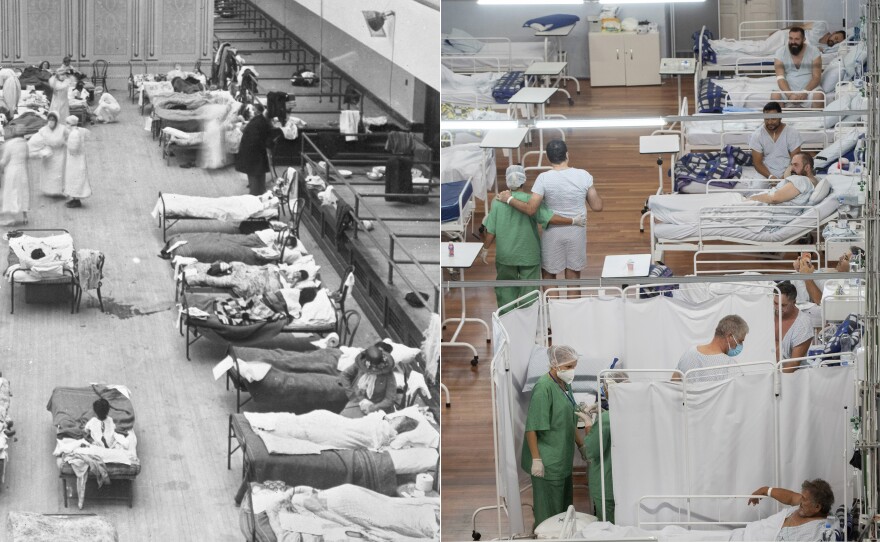It's commonly referred to as the Spanish Flu, but that's a misnomer, as there's no consensus it started in Spain. If you call it the 1918 Influenza pandemic, that's not quite accurate either. The CDC says flu season in the United States typically ramps up in October and peaks between December and February. Dr. Carl Fichtenbaum says that pandemic wasn't like that.
"It lasted far more than a flu season. It lasted for a couple of years around the world," he says. "There were different waves at different times in different countries."

Fichtenbaum is a professor of infectious diseases at the University of Cincinnati. He says records from several countries show three waves of flu.
"Most likely it did exactly what the coronavirus is doing now, which is that there were changes, there were mutations. There were variants."
Fichtenbaum says the records of the period aren't good enough to demonstrate how the virus changed from wave to wave. He says medicine looked a lot different then.
"There were no vaccines," he says. "There was no specific treatment. There was actually very little in the way of oxygen that was really available for the treatment. There were no intensive care units."

There are some similarities between the influenza and coronavirus pandemics. Fichtenbaum says the human response to the 1918 illness is very familiar.
"Some physicians recognized that this was probably a respiratory illness and that people should be wearing masks. Other people objected to the idea of wearing masks. What a strange phenomena," he says. "And there were people who said you should be separated out if you're sick. Let's put all the sick people together and keep them away from the healthy people."

The flu stuck around, by some accounts until 1920. Some historians point to a fourth wave that hit a few scattered American cities, and assorted nations. After that, the virus petered out.
"There were no longer big spikes, because probably most people had been infected by then and had developed a measure of immunity so it wasn't spreading quite as much," Fichtenbaum says. "And it wasn't spreading at times when we wouldn't expect influenza to spread."
Fichtenbaum says the pandemic ended not because of a vaccine. There wasn't one. It wasn't masking, or isolation that stopped it either. He says it ended because of herd immunity. But that immunity came at a cost. There were an estimated 675,000 deaths in the United States, and at least 50 million deaths worldwide.
Both pandemics revealed some things about us
The pandemic transformed the world in a lot of ways. Fichtenbaum says it led to more medical research and better ideas about public health. He says those are the most important lessons.
"Unfortunately most humans have a very short memory. And we do not learn very well from history. We are very suspect," he says. "There's this kind of feeling that 'Well, you need to really prove to me that this works.' "

Fichtenbaum says both pandemics, influenza and the coronavirus, revealed a number of flaws in society: a lack of critical thinking skills, along with poor messaging, conflicting recommendations, and bad decisions from public health officials, politicians and military leaders.
"When you are not an open-minded, critical thinker willing to look at history, you are destined to make the same mistakes that were made at the time of a previous pandemic, because all emergency situations threaten people in such a way that makes it hard to make decisions."
Fichtenbaum says had more people learned from history, there would have been fewer deaths from COVID-19.
This story is part of a series as WVXU looks at the COVID-19 pandemic and the effects its had on our world.



